Do you know the difference between a hooded nib, an inlaid nib, and an inset nib? I didn't, until the new Sheaffer Legacy was recently released, and I decided to immerse myself in the fascinating world of modern fountain pens with these beautiful and intriguing vintage-inspired nibs. If, like me, you love the sleek mid-century modern movement that shaped product design, interior design, graphic design, and architecture in the post-WWII period (approximately 1945 to 1970), then now is a great time to explore pens with these intriguing nibs, as they have been making a small resurgence. Right now we have seven different models, which range in retail price from $125 for the steel nibbed Diplomat Viper to $720 for the 18K gold nibbed sterling silver Pilot Silvern!
Inlaid Nibs & the Sheaffer Legacy
First of all, I must give credit to fountain pen collector and expert Richard Binder's exhaustive "Glossopedia of Pen Terms" for the definitive definitions of these various types of nibs. His website is an amazing resource and I highly recommend it, especially if you want to learn more about vintage pens. As Mr. Binder explains, an inlaid nib was Sheaffer's term for its "unique, and uniquely timeless, nib that is mounted flush with (inlaid into) the surface of the gripping section."
This patented technique was first introduced in 1959 on Sheaffer's PFM (Pen For Men) pen, an ancestor of the Sheaffer Legacy we have today. Pens with inlaid nibs, such as Sheaffer's PFM, Imperial, Targa and Slim Targa, Intrigue, Valor, and Legacy series are made by inserting the finished nib into a mold cavity, then injection-molding the plastic shell of the pen's gripping section around the nib to create a seamless and inseparable entity in which the pen and nib elegantly merge.

My vintage pen expert friend Myk Daigle explained to me that the nib itself actually has little tabs that are folded in the back and extend behind the plastic to secure it into place. Here's a closeup photo of a Sheaffer Legacy R and D demonstrator model nib unit that Myk showed me on eBay. Photo credit goes to the seller, redc-71. It's so cool to be able to see this! Myk also sent me a link to an extremely interesting article about Sheaffer's inlaid nib and how it is made. I love the step by step photos. Check it out if you'd like to know more about this iconic nib and the vintage pens that feature it!

[Sheaffer Legacy R and D demonstrator model nib unit. Photo credit: edc-71 on eBay!]
This type of nib was also used in a few short-lived Japanese pen models in the 1960s, but other pens with similar nibs that seamlessly emerge from the section (such as Pilot's E95s), have inset nibs, not inlaid. Unlike an inlaid nib, an inset nib does not have part of the pen's body embedded into it.
The Sheaffer Legacy has a classic elegance and a very sturdy feel. At 43 grams, it's a weighty--but very well-balanced--pen, and feels good in my hand both with the cap posted or set aside. Sheaffer describes the Legacy as just like "a vintage car brought back with a new engine under the hood... sleek, powerful, and better than ever." The iconic model with its signature inlaid nib, "once a favorite among collectors and writers alike" has been fully modernized and uses Sheaffer's cartridge/converter filling system. The pen is built on brass, with a shiny black lacquer finish and chrome accents, and the snap cap posts securely. Its inlaid nib is steel and available in medium only.

The Legacy comes in a very nice gift box that includes a warranty booklet/welcome guide, cleaning cloth, two ink cartridges, matching grey leather pen sleeve embossed with "A Timeless Innovation." The converter is installed in the pen. At the time of this article's release, it retails for $265, and it is also available in rollerball and ballpoint versions.
Sheaffer is an American company that was founded in 1912 by Walter A. Sheaffer, and is one of the most well known brands from the vintage pen era. Sheaffer pens are easily recognized by their the iconic “White Dot” symbolizing excellence, and the brand is now distributed in the U.S. by Kenro Industries, which also owns Esterbrook and distributes Aurora, ystudio, and Ferris Wheel Press, among others.
Inset Nibs
Mr. Binder explains an inset nib (also known as a "quasi-inlaid nib") as a nib that is "inset into an opening in a shell-type section such that the nib is flush or nearly flush with the shell's surface." This type of nib is usually secured into place by an adhesive, but can be removed for repair or replacement if necessary. Well-known examples of pens with this type of nib include the Pilot E95s (also called the Pilot Elite) and the Waterman Carène, both pictured below, along with the Carène's converter and some standard international cartridges.

Inset nibs remind me of a perfectly manicured fingernail, and I think they are beautiful! The Pilot E95s and Waterman Carene are both very well-respected and popular pens with a tried and true reputation for reliability, smoothness, and an elegant vintage look.
Pilot E95s
My introduction to inset nibs came when I bought my third-ever fountain pen, a petite E95s in burgundy and ivory. I often recommend the E95s to customers looking for their first gold nib, because it's an excellent value and is one of the most inexpensive gold nib pens you can find. Right now, the retail price is $200. It's also an amazing pen and a wonderful writer, well loved by Pen Boutique's staff and customers, and easily lives up to Japanese pen giant Pilot's 100+ year reputation for reliability and quality.
I chose the E95s because I was extremely attracted to this graceful pocket pen's streamlined mid-century design, and I still am. The beautiful 14k inset nib is buttery smooth, and I still think my medium E95s is the smoothest writing pen I own. The Pilot E95s' legacy goes back to the 1960s, when it was introduced as the Elite, a name that is still used in Japan for the contemporary model.

Pilot Elites that are very similar to the modern pen were released in the 1970s, and I also own a "new old stock" silver crosshatched vintage Pilot Elite with an 18k fine nib that is dated 1975. If you look closely at the exposed lower part of a Pilot Elite/E95s nib, you can see letters and numbers that tell you the factory where it was built, along with the month and year. My vintage pen says H1175 on the nib, which means it was made in November 1975 at the Hiratsaku facility.

Back in the 1970s, other Japanese pen brands including Sailor made extremely similar pens with inset nibs, and Pilot had other models besides the Elite, as well, but the E95s is special now. I love the Pilot E95s/Elite so much that I also bought a black one in EF, and I adore its precision. As you can see, the inset nib differs slightly between my modern and vintage models.
The E95s is available in extra fine, fine, and medium, and the pen currently comes in two variations: the elegant solid Black and the unique two-tone Burgundy/Ivory, which has been discontinued in all markets except the US, and will remain as a US exclusive color now. Both versions have gold trim and use Pilot's CON-40 converter or cartridges.
Pilot's Sterling Silver Pens
Pilot's E95s nib is unique, but it's most similar in shape to the 18k gold, rhodium-plated nib in Pilot's Silvern Collection and the recently discontinued Sterling Collection. The sterling silver pens in both of these collections are elegant and luxurious works of art that capture the essence of Japanese culture and craftsmanship. Below is a closeup of the inset E95s nib (left) and the larger inset nib found in the sterling silver pens (right).

In my photo below, you can see two E95s and two Silvern pens side by side. As you can see, the E95s is a long/short style pen with a proportionally extra-long cap, meant to be very compact when capped but comfortable to write with with posted, while the sterling silver pens, on the other hand, have more traditional proportions. The Silvern Collection and Sterling Collection are also slightly thicker than the E95s; plus, they are much heavier (35 g vs. 15 g).

The Sterling Collection, which included fountain pens featuring animals, along with a Mt. Fuji seascape, were meticulously etched with traditional Japanese designs. We still have one Hawk fountain pen remaining in stock, and Pilot has very limited stock of Jaguar (the only numbered limited edition design in the collection, offered at the same price as the other pens), but all the others are gone. If you'd like to inquire about ordering a Jaguar, please contact our customer support.
Fortunately, the gorgeous Silvern Collection remains! Silvern features hand-wrought, sterling silver pens with distinctive Ishidatami, Koushi and Tsumugi patterns inspired by traditional works of art that embody Japanese culture. Each pen offers an intricate, meaningful design. I love both the look and unique textures of these pens, and I've actually had one on my wishlist for over six years. In this photo, Ishidatami is on the left, and Koushi lies to the right.

Ishidatami features an intricate, geometric design inspired by the traditional Japanese garden element known as ishidatami, which is made up of small, flat stones arranged in a pattern. It reminds me a little of alligator or crocodile skin, and has a wonderful subtle bumpy texture! I love how varied the shapes and sizes of the stones represented in the pattern are.
 The Koushi design pays homage to traditional Japanese interior design, resembling the delicate grid patterns of shoji screens. This texture is so different, but incredibly pleasing, too! Its uniformity and the fineness of the scale are soothing to the eye and to the fingers.
The Koushi design pays homage to traditional Japanese interior design, resembling the delicate grid patterns of shoji screens. This texture is so different, but incredibly pleasing, too! Its uniformity and the fineness of the scale are soothing to the eye and to the fingers.
Tsumugi, my personal favorite, draws inspiration from the luxurious texture of raw silk fabrics. It almost resembles the grain of some kind of wood, and its complex repeating pattern is fascinating. Pilot is backordered in the Tsumugi design right now, but we have it on order!

These pens all feel incredible in the hand and can be used either posted or with the cap set to the side. Although they are fairly heavy, the weight is perfectly balanced, and, like many of the other pens in this article, you choose how close to the tip you prefer to hold them, as the pen smoothly transitions from nib to extended grip section.

My friend Warkenda owns one of these pens and kindly allowed me to borrow it so I could try the nib for this article. It's incredible! The large size, unusual shape, and softness of the 18K gold produces a beautiful and very expressive variation in line width, depending on the pressure you put into your stroke. When I allow her fine nib to glide lightly over the page, it writes with a supremely satisfying precision, but, when I add some gentle pressure, the line changes almost as much as the one produced by my flex nib pens!

The Silvern Collection is offered with a fine or medium 18K gold rhodium-plated nib, both of which are extremely smooth and sumptuous. These very special pens use Pilot's CON-40 converter or cartridges, and retail for $720.
Waterman Carène
The Waterman Carène is another pen I've long admired, and it was the subject of one of my blog articles back in March, 2023. Its retail price ranges from $358 to $460 at the time of this article's release, depending on which one you choose. Carene is a very classic and classy pen. The word "carène" means "hull" in French, and the pen is designed to call to mind the hull of a racing yacht. Carène isn't a flashy pen, but rather one that conveys an effortless sophistication and debonair charm.
The person who first shared his love for this pen with me was Raj, our COO (Chief Operating Officer) and husband of Pen Boutique owner, Leena. Raj told me that, as a young man growing up in India, fountain pens were mandatory in school. His dad got him a Hero pen, which is basically a copy of the Parker 51, and that was the beginning of his devotion to hooded, inset, and inlaid nibs. Carène is his favorite pen.
Raj studied at SBOA, one of the most competitive colleges in India, and they trained him to write very fast and write a lot. In business school, Raj honed his writing skills with numerous essays, along with copious class notes, of course. He feels like he can write much faster with this type of nib, and says his pen needs to have a fine point so it won't smear. Raj told me a ballpoint pen will start skipping due to friction when it heats up, so, for him, using a fountain pen is crucial.
When I tried writing with the Carène, I understood what he meant.
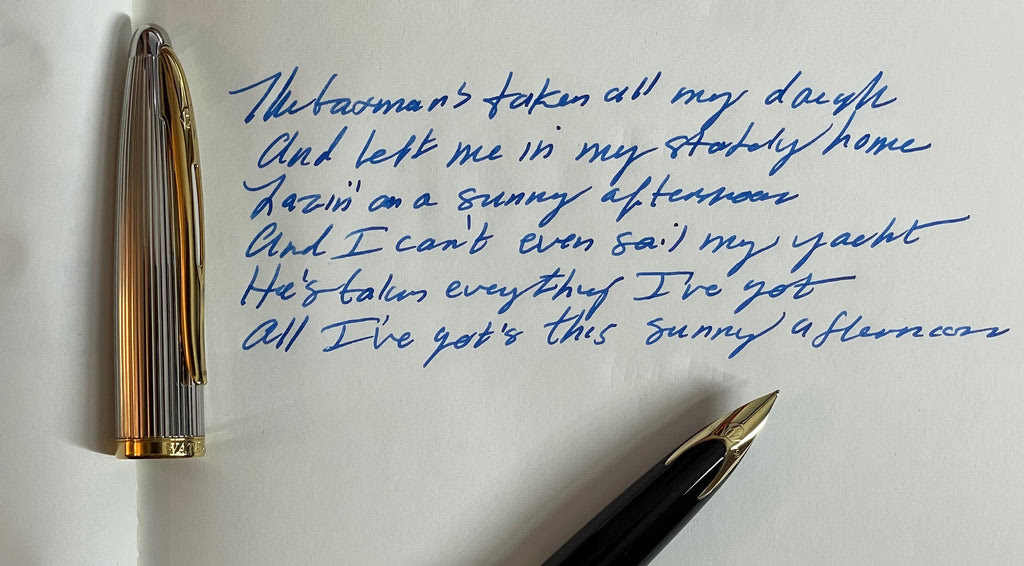
I'm not sure if you can read my fast handwriting, but, I can, and that's what's important! As Waterman describes it, "The Carène's exquisite integrated nib complements its unconventional curved design and is crafted to glide effortlessly across the page."
With his craving for writing speed, I think it's apt that Raj's pen of choice was inspired by a speedboat! The Carène's streamlined, aerodynamic look makes it appear as though it's zooming through the water, parting the waves with ease. I love the curve of the clip, and the way it gracefully rises at the end, with a gentle sweep that feels wonderful to run your finger along.
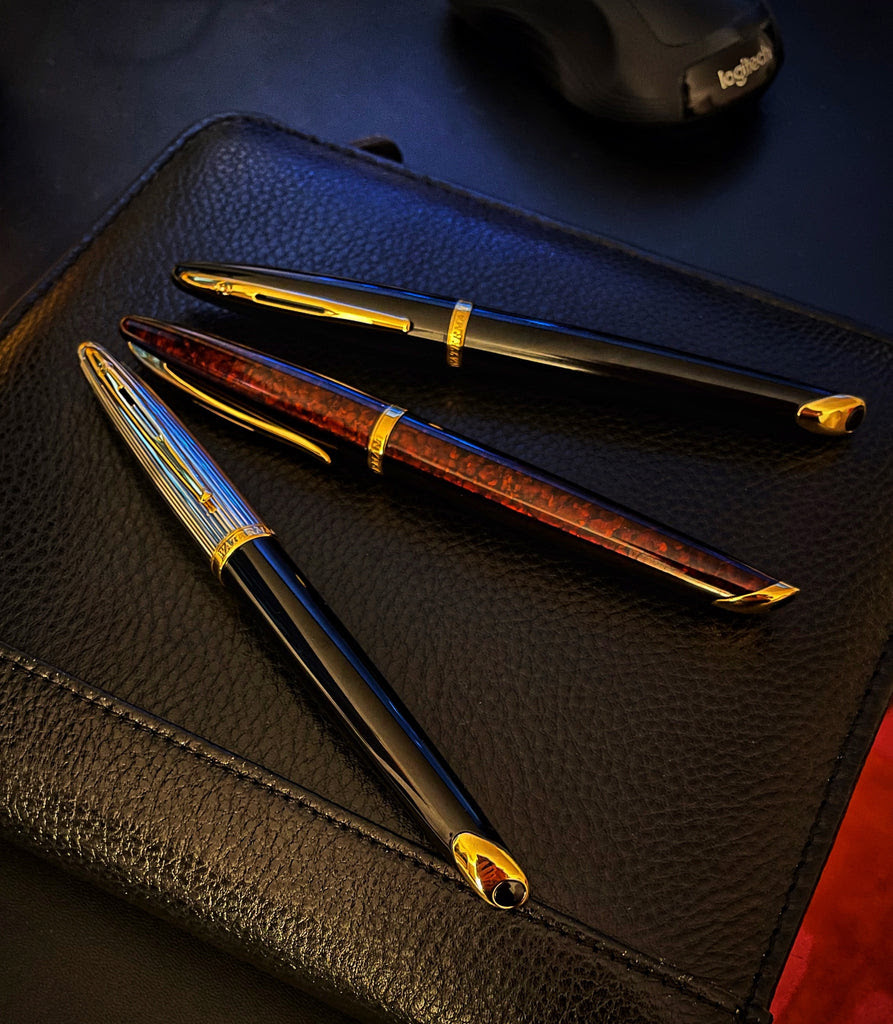
The clip is spring-loaded, so the pen clips easily to a shirt pocket, and slides right into the elastic slots of a pen case. I love the feeling of slipping the Carènes in and out of my Yak leather case, and of clipping them onto my notebook. It's so effortless and satisfying!
When I wrote slower and more carefully, I was very impressed with the Carène's 18k gold nib and the control I felt. This pen has amazing balance, both posted or with the cap set to the side, and, as with other similar pens in this article, I love how it's up to the user where to hold along the grip section. You can comfortably grasp the pen as close to the nib or as far back as you'd like, without any transitions between the nib/feed section, grip section, and pen's body digging into your fingers--and, because this is a convenient (and secure) snap cap, there are no annoying threads, either. As you can see, my natural inclination was to hold the pen extremely close to the tip, which allowed me great precision but never got my fingers inky.
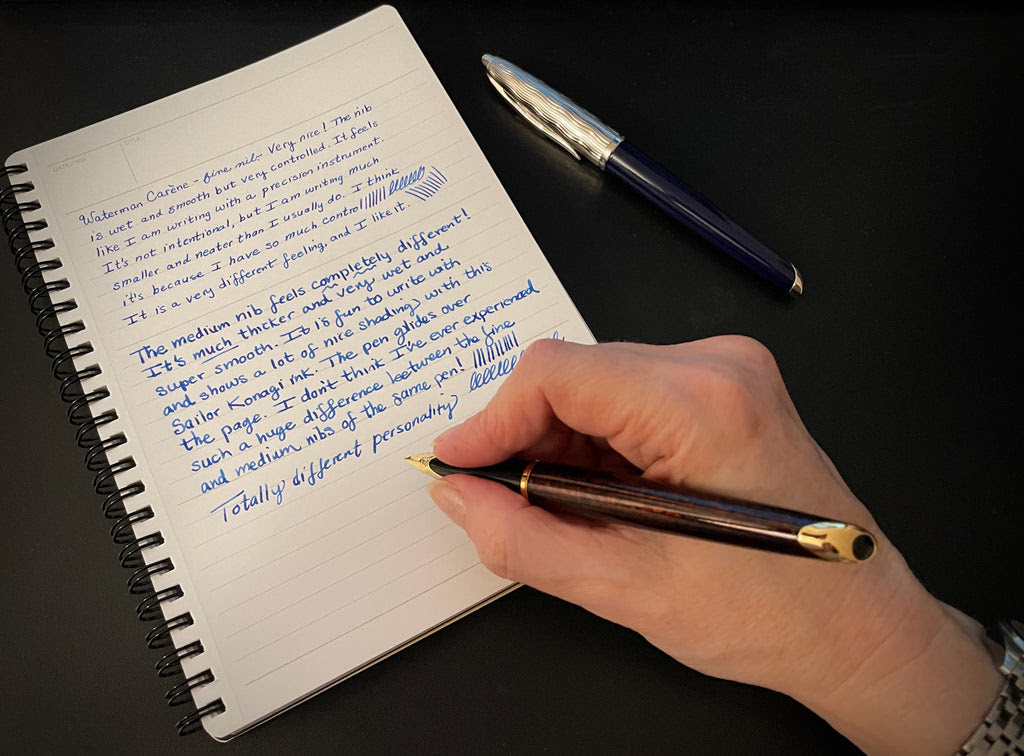
The Carène is a mid-sized pen, and weighs 33 grams capped, or 23 grams uncapped, when empty. To me, this is an extremely comfortable size--neither too heavy nor too light, and I think it's suitable for both men's and women's hands. The barrel is lacquered brass, but it feels almost weightless when I write with it.
Incidentally, you may have noticed that the nib size isn't written on the nib. It's actually imprinted on the underside, near the breather hole on the bottom of the nib section. In order to get a full fill from a bottle of ink, be sure to fully submerge the breather hole. You will find the breather hole in this location on many of the pens in this article.
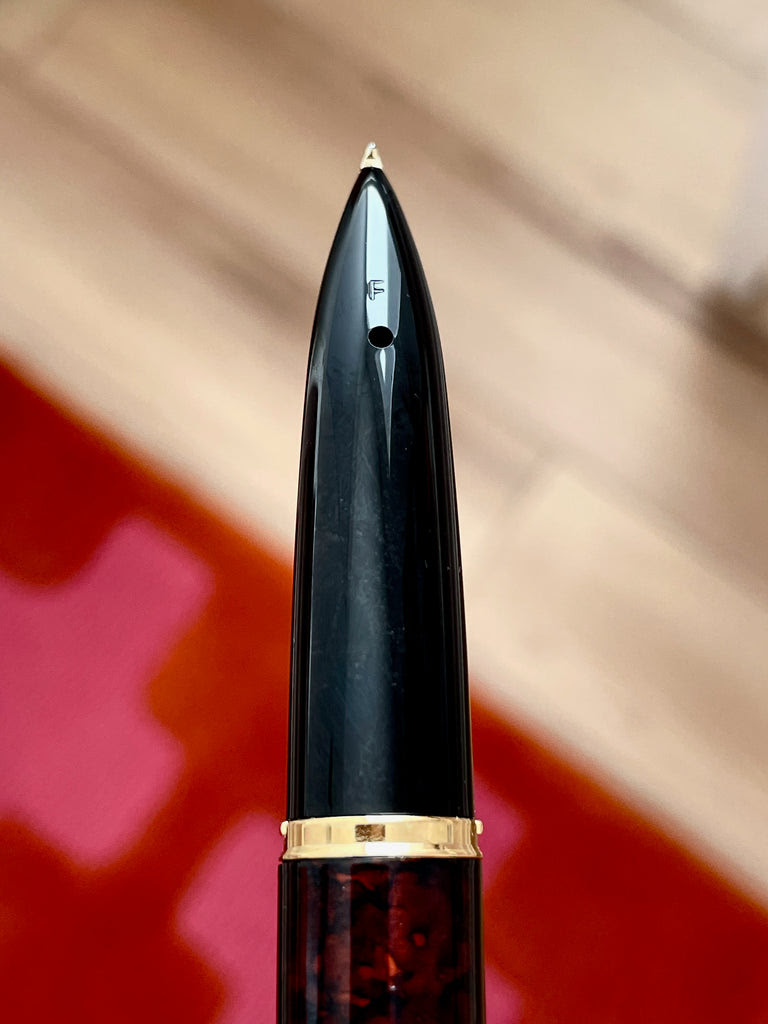
Raj told me he got accustomed to the hooded nib fountain pens he practiced with in school, and when he started to try other fountain pen pens with larger nibs, his handwriting was not the same! He was frustrated at first, but then stumbled upon Waterman Carène and found his ideal pen. "I love the smoothness it writes with, and the weight and balance is superb. It is a breeze to write with."
I agree. Not only is the Carène different and attractive, it feels wonderful in the hand and is the kind of pen that becomes a favorite, a loyal companion that is part of your identity and is ready to accompany you wherever your dreams take you.
I can't quite decide which Carène variation is my favorite, but the Marine Amber is the most unique color and really looks breathtaking in the sunlight.
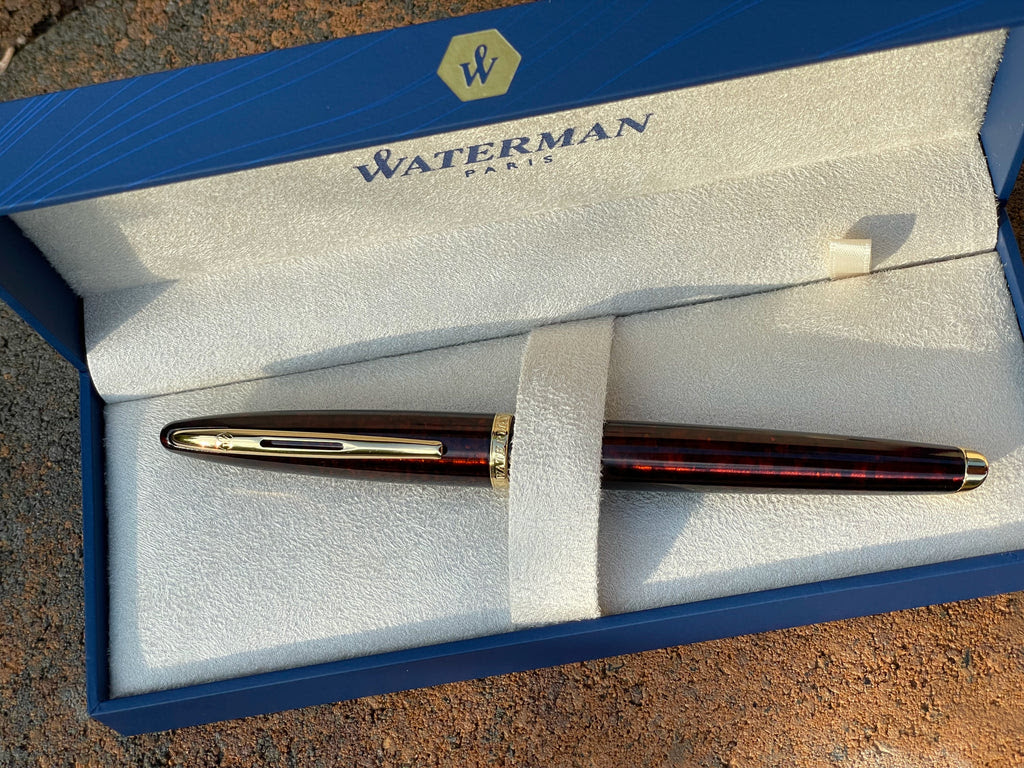
The L’Essence du Bleu Carène, which features deep blue lacquer on the barrel and Waterman's signature wave pattern etched on the palladium plated cap, catches my eye most often, along with the newer Reflections of Paris, which is similar to L’Essence du Bleu, but incorporates both palladium and gold into the same pen, and has a thinner shimmering wave pattern that evokes the Seine River. Instead of blue, the lacquered barrel is black. It's an extremely elegant combination! As a water lover, these pens make me feel serene and call to mind many happy memories. I love the way the light catches in the wavy pattern on the cap and constantly changes, just like the way sunlight does on waves in water.
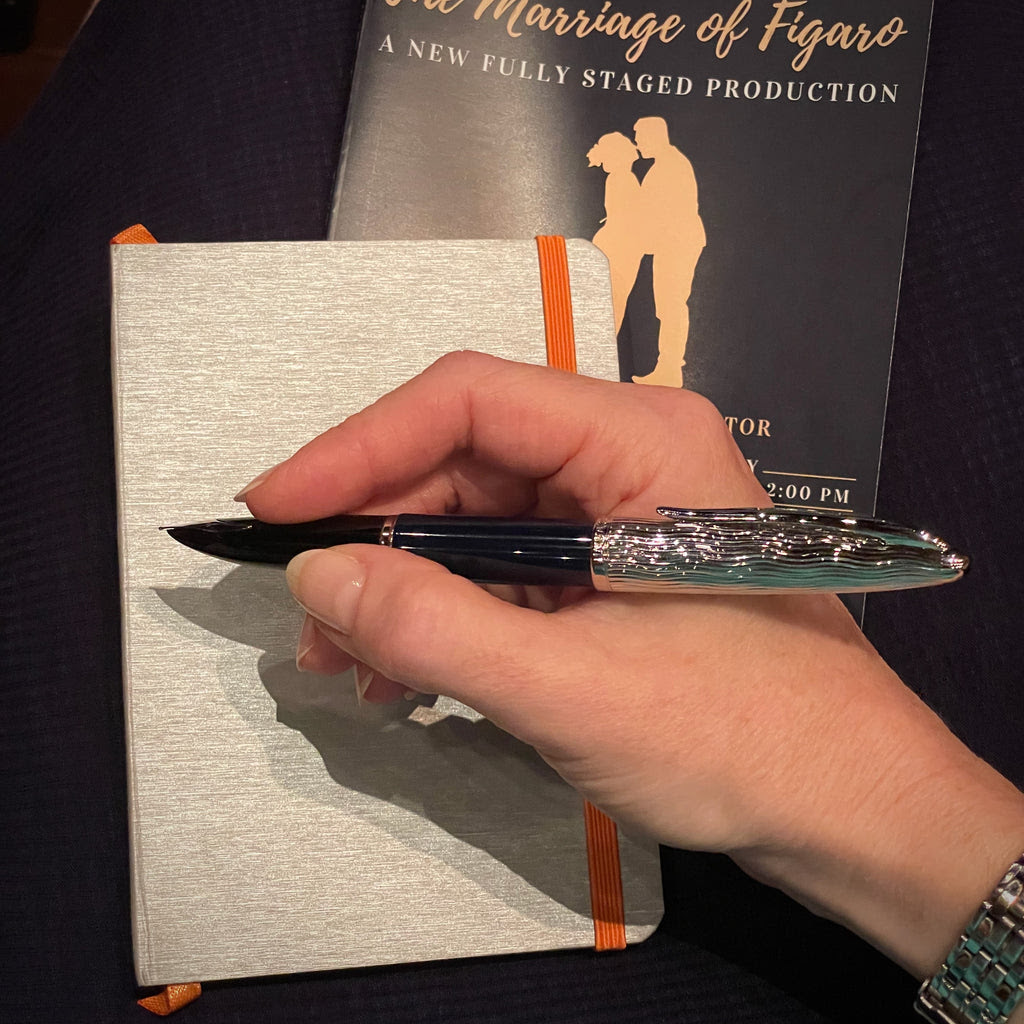
I also love the simplicity and effortless cool of the Black Sea Carène with Silver Trim. This version of the pen looks the most modern to me, and is so streamlined and sleek, like a beautiful luxury sports coupe.
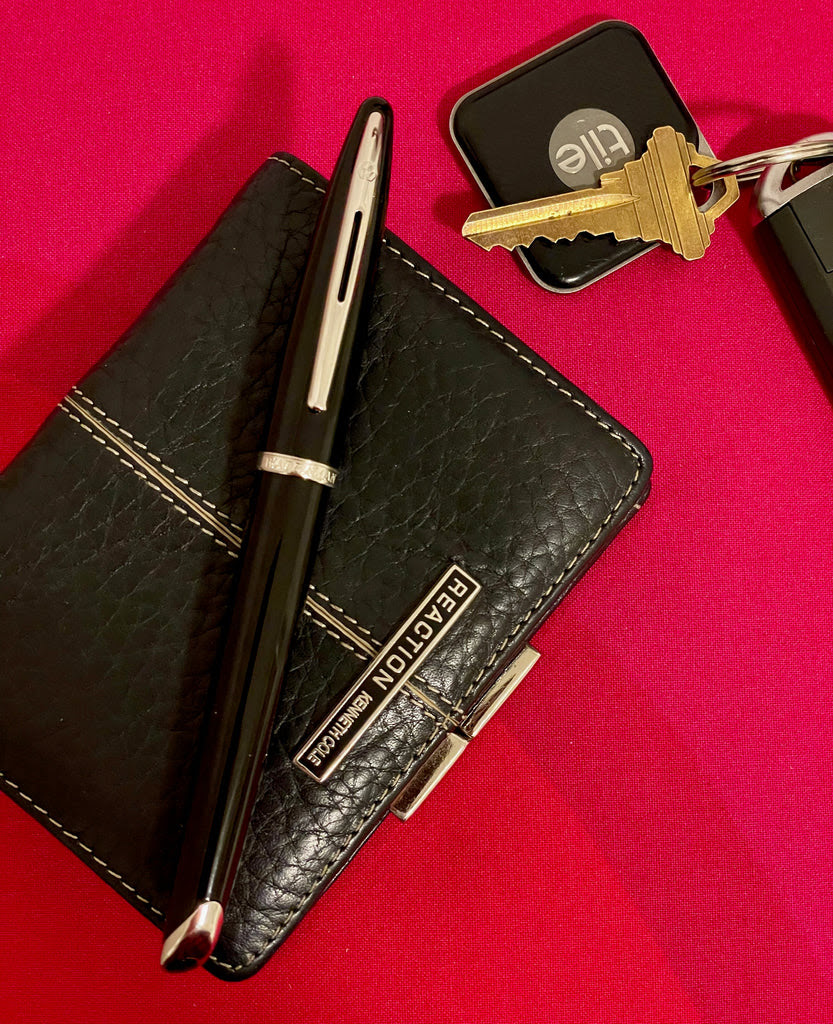
The Carène comes with a very high quality converter and a Waterman Serenity Blue long cartridge. It takes Standard International cartridges, so you can easily fill it with many brands' long or short cartridges on the go. Waterman is a highly respected luxury pen brand that was established in 1884 in New York City. Today, Waterman is headquartered in Paris, but is still owned by an American company, Newell Brands. All their fine pens are made in France, and are inspired by Parisian style, representing a timeless display of taste and self-assurance.
Hooded Nibs: Défi, Viper, and 2000
As Richard Binder tells us in his "Glossopedia of Pen Terms," a hooded nib is "enclosed in a conical shell, or hood, so that the nib is all but invisible." The famous Parker 51 was the first fountain pen with a hooded nib. (By the way, the term for an exposed nib is an "open nib." This describes the majority of nibs.) Parker made modern "51" models until very recently, but they have now been discontinued, so I won't be featuring them in this article. However, if you are interested in fountain pen history, check out the website, Parker51.com, which includes a wealth of information on this very influential fountain pen, one of the most revolutionary, beloved, and successful ever made.
Pen Boutique currently carries three pens that fit in the hooded nib category: the sleek and modern Défi Millennium from internationally famous Parisian luxury penmaker S.T. Dupont; Lamy's flagship, the Lamy 2000, the timeless classic designed by German industrial designer Gerd A. Müller in 1966; and the new Diplomat Viper, an affordable and approachable creation with a cool serpentine texture, introduced in late 2024.
My section featuring the hooded nib pens is going to be shorter, and I apologize. When I decided to write this article, I bit off a little more than I could chew, and a series of important things came up that needed my attention, allowing me less time than I would have hoped. However, I loved briefly exploring these three very different pens! Both the Défi Millennium and Viper feature magnetic caps and steel nibs, but these two are on the opposite ends of the spectrum as far as hooded nib fountain pens go, and the Lamy 2000 stands alone, design-wise.
The Défi Millennium retails for $450 and has a very futuristic, athletic, and masculine look, along with a premium feel. The S.T. Dupont brand, founded in 1872 by Simon Tissot-Dupont, exudes effortless luxury and cool, and is famous for designing the first luxury ballpoint pen, the “Classique S.T. Dupont,” to satisfy a request from Jackie Kennedy Onassis. This pen, completely redesigned and updated in 2023, was inspired by sports cars, and reminds me of Tony Stark/Iron Man. It has a high gloss lacquer barrel, shiny chrome finish, and spring-loaded clip, along with an impressive 48 g weight.

The Défi Millennium comes in quite a few different colors, but I photographed the striking shiny red and shiny black versions. The sleek design is also available as a ballpoint and rollerball.

The Viper is a new pen that German brand Diplomat "designed to offer exceptional value for a controlled budget, making it accessible to both pen enthusiasts and professionals seeking a high-quality tool." It retails $125, and is a hit with our customers so far! Along with the cool hooded nib look, the Viper's aluminum cap and body with diamond scale-patterned guilloché engraving are very striking. The reptilian texture is subtle, and has a smoother feel than you would expect from looking at it. At 29 g, it is fairly lightweight, has good balance, and feels nice in the hand. The pen looks especially great when the sunlight hits it and highlights its scales!

I really like the way the Viper plays with light and shadow, and its color options are quite nice, too. My photos here are of the blue version, but there is also a black version, an exciting new green that will be released in late August, and a sophisticated brown that you can see in my cover photo. Brown has been a very popular pen color this past year, and the Viper captures the lovely mocha shade that customers have been particularly drawn to. Capped, the Viper has a conservative and professional look, but with its textured twist to give it a little bite.
 The final pen is a big one, with a reputation and following that puts it in a truly elevated place in the world of modern fountain pens. Winner of design awards and beloved as a classic that has remained virtually unchanged since its introduction in 1966, the Lamy 2000 has a cult following as an everyday carry "workhorse" pen and is the pen that shaped the design principles and reputation that Lamy is known for today.
The final pen is a big one, with a reputation and following that puts it in a truly elevated place in the world of modern fountain pens. Winner of design awards and beloved as a classic that has remained virtually unchanged since its introduction in 1966, the Lamy 2000 has a cult following as an everyday carry "workhorse" pen and is the pen that shaped the design principles and reputation that Lamy is known for today.
German industrial designer Gerd A. Müller took inspiration for his design from the principles of the Bauhaus and other German modernist schools from the early 20th century, creating a pen with a clean, minimalist look. The Bauhaus school was famous for its attempt to unify crafts, fine arts, and technology, and envisioned a harmony between form and function, featuring elements like simple geometric shapes such as rectangles and circles, rounded corners, and rectangular protruding features.

The smooth, balanced shape of the Lamy 2000, with its streamlined, gently curved body and crisp rectangular clip is both beautiful and practical in its simplicity and functionality. The cap snaps into place with a completely smooth transition between grip section and the pen's barrel, save for two tiny metal tabs right above the grip section that hold the cap securely onto the pen but are incredibly inconspicuous. I like how they feel when I lightly run my fingers over the brushed finish of the pen. The gently sloping shape is comfortable, perfectly balanced, and has a harmonious and calming look.
The subtle texture of the brushed surface has both aesthetic and functional benefits: it gives the pen a pleasing soft, matte look, hides fingerprints and scratches, and makes the surface more grippable. I love the way light reflects softly off the surface, and the contrast between the pen's body and clip.

The original Lamy 2000 is made from Makrolon polycarbonate, a very strong fiberglass material, and it features a stainless steel grip section. Makrolon was developed by Bayer, and is used in many industries as an alternative to glass because it is so durable, impact-resistant, lightweight, and long-lasting. It can be made transparent (like in the pen's slim ink window), and is recyclable. The Lamy 2000 is wonderfully light in your hand, in a way that feels deliberate and remarkable, rather than cheap. When you look at and touch the pen, it's hard to tell what the material is, and I honestly had no idea what Makrolon meant until I wrote this article.

For Lamy 2000 lovers who prefer more weight, there's another option. Visually, the black Makrolon pen and the silver stainless steel version look very similar, but, when you pick them up, the difference is dramatic. At 54 g, the silver colored pen weighs more than twice as much as the black one, and is the heaviest pen included in this article! Despite its heavy weight, it is also perfectly balanced and feels very comfortable and satisfying in my hand. The stainless steel version of the pen is also considerably more expensive: right now the Makrolon version has a retail price of $279, and the stainless one is $399.

Both versions feature a virtually invisible piston knob at the end of the barrel, and the pens hold over 1 ml of ink, more than most cartridges or converters, so Lamy 2000s fans love how long they can write. It's the only piston-filling pen in this article. The Lamy 2000's semi-hooded rhodium-plated 14 K gold nib is smooth and fairly wet, with a stiff and exacting feel that suits the pen's personality. With its German precision and perfectionist's stark beauty, it's not the pen for everyone, but it's a cult classic for a reason!
I love how much variety there is in the hooded, inset, and inlaid nib category! Although these pens all share a streamlined aesthetic and seem simultaneously futuristic and retro, each one has a different style and holds a different appeal. Do you have a favorite modern or vintage pen with one of these fascinating nibs? Which one do you think I should explore further?
-Laura P.
I love comments on my blog! Please leave comments if you like the articles, and, if you have any questions about this article, or any of the other blog articles, you can e-mail support @ penboutique.com. Thank you!

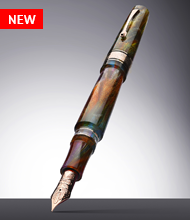
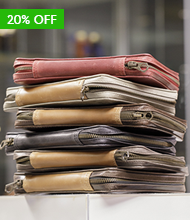

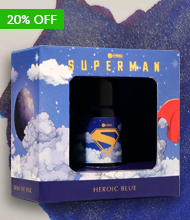
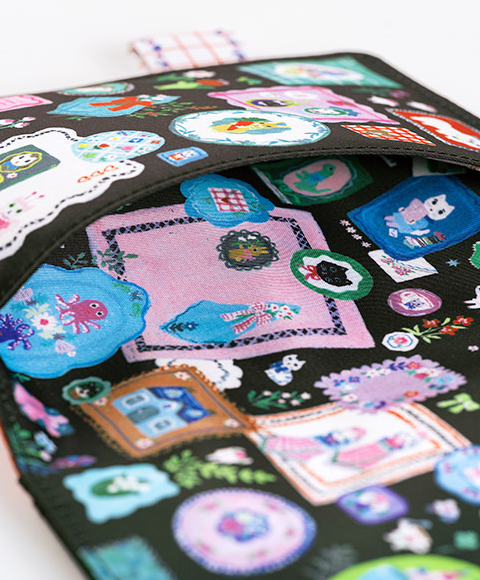
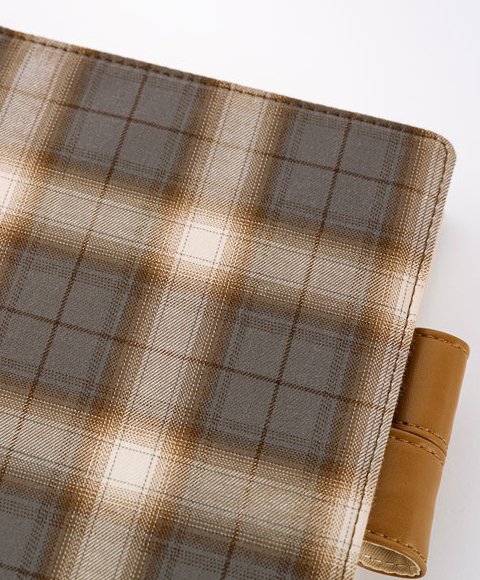
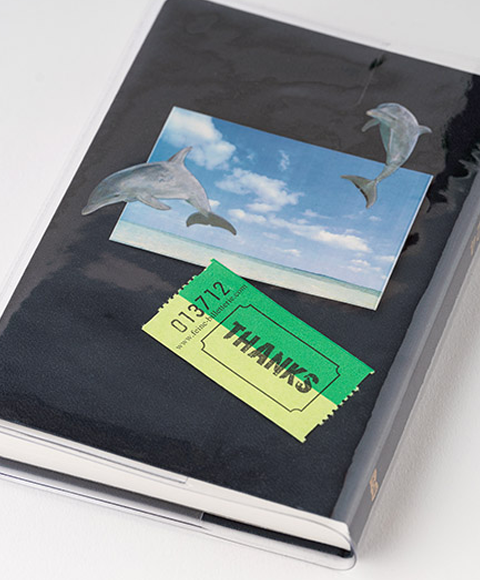
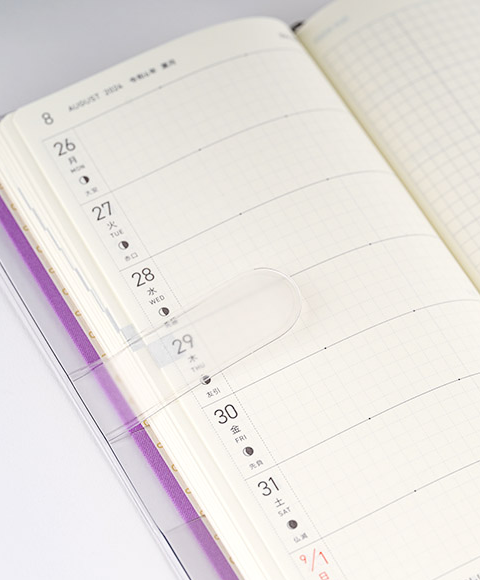
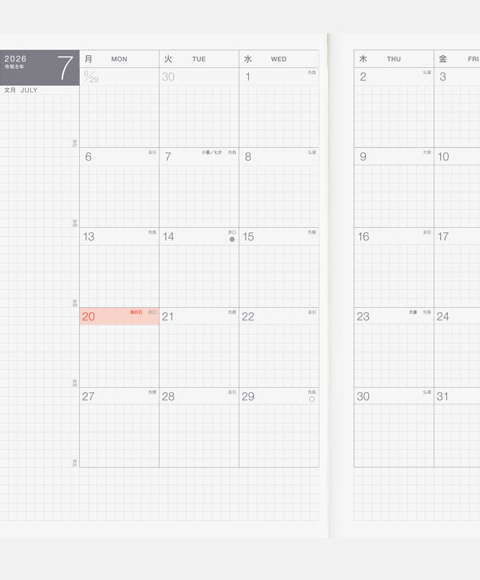




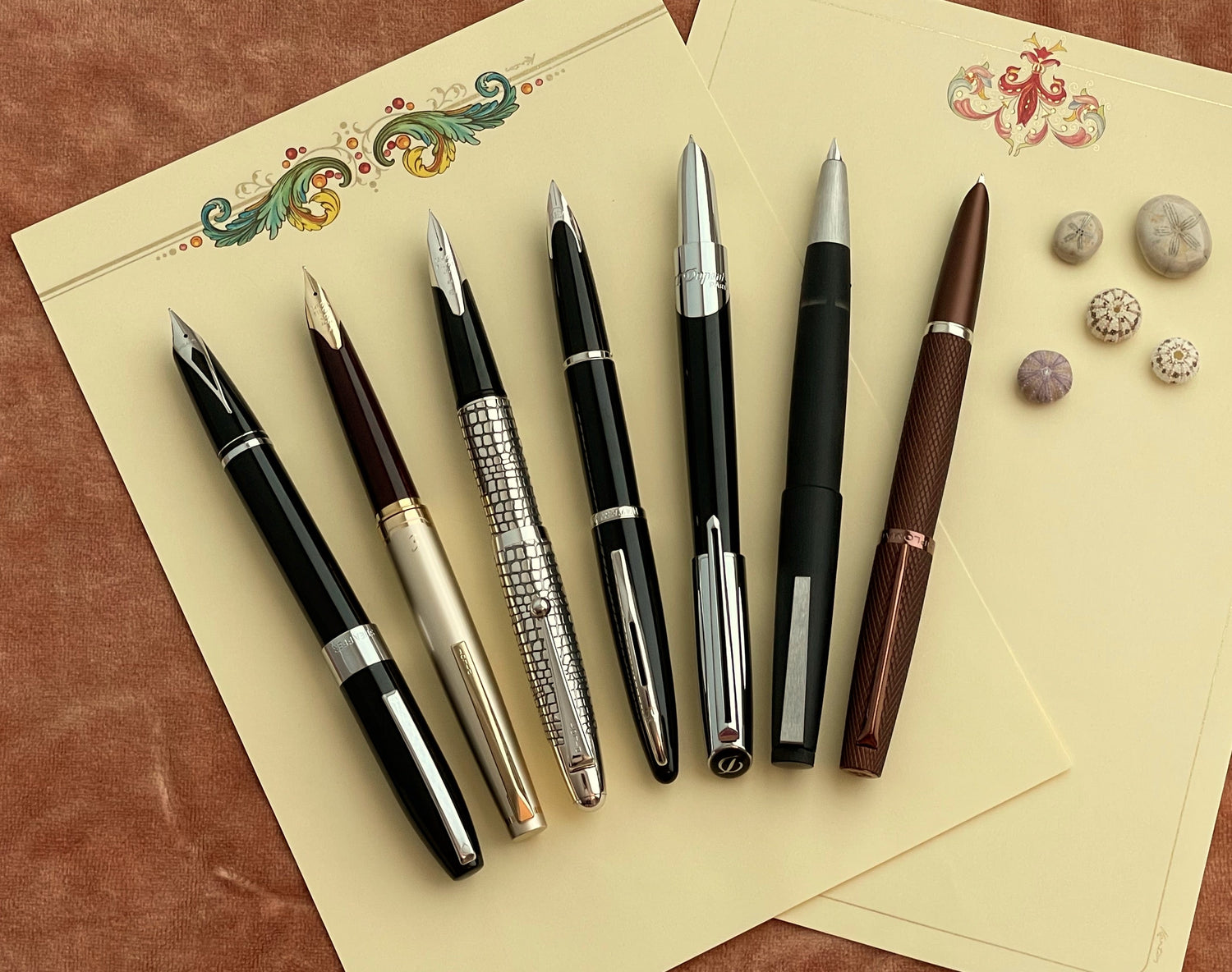
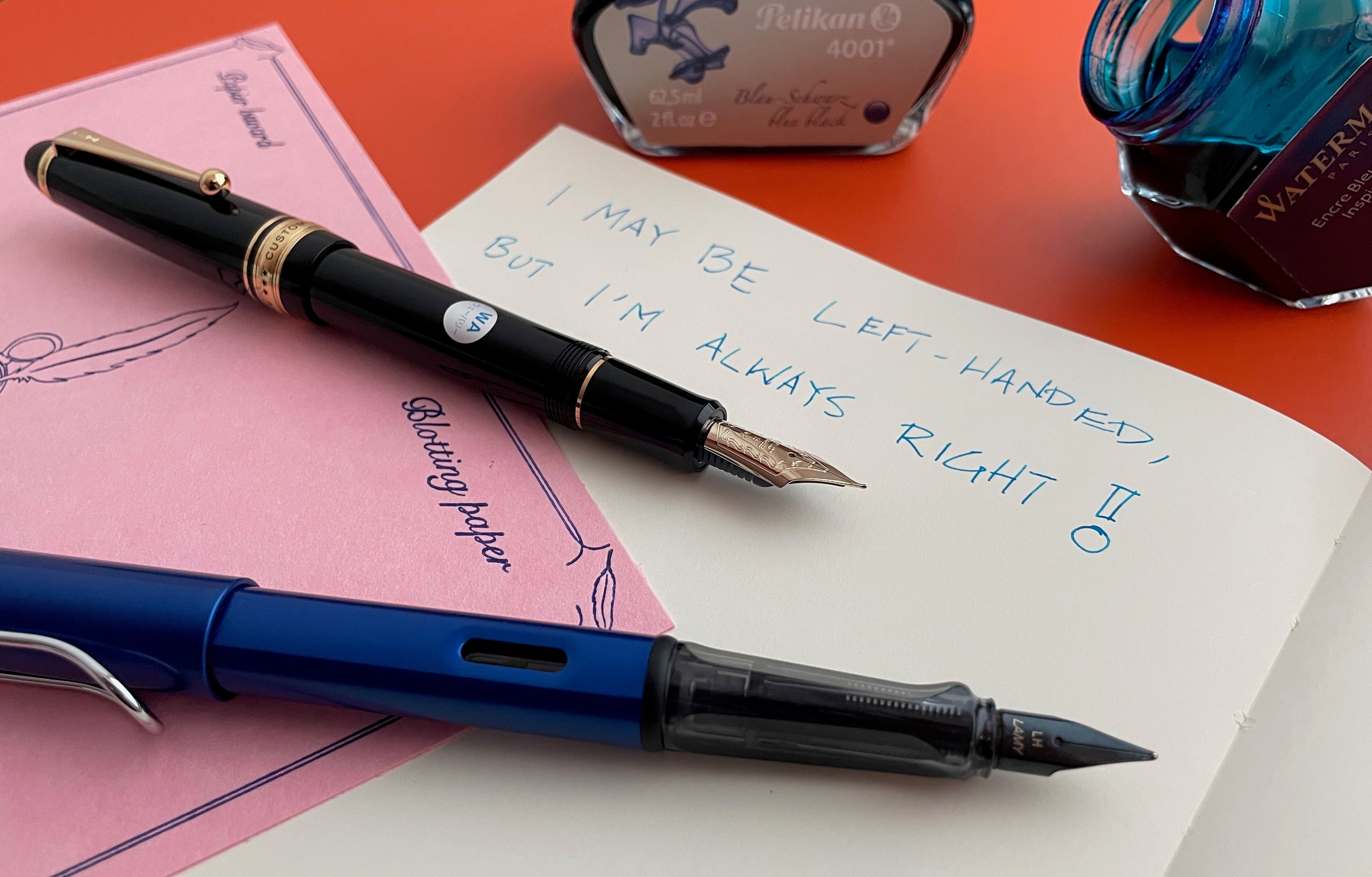


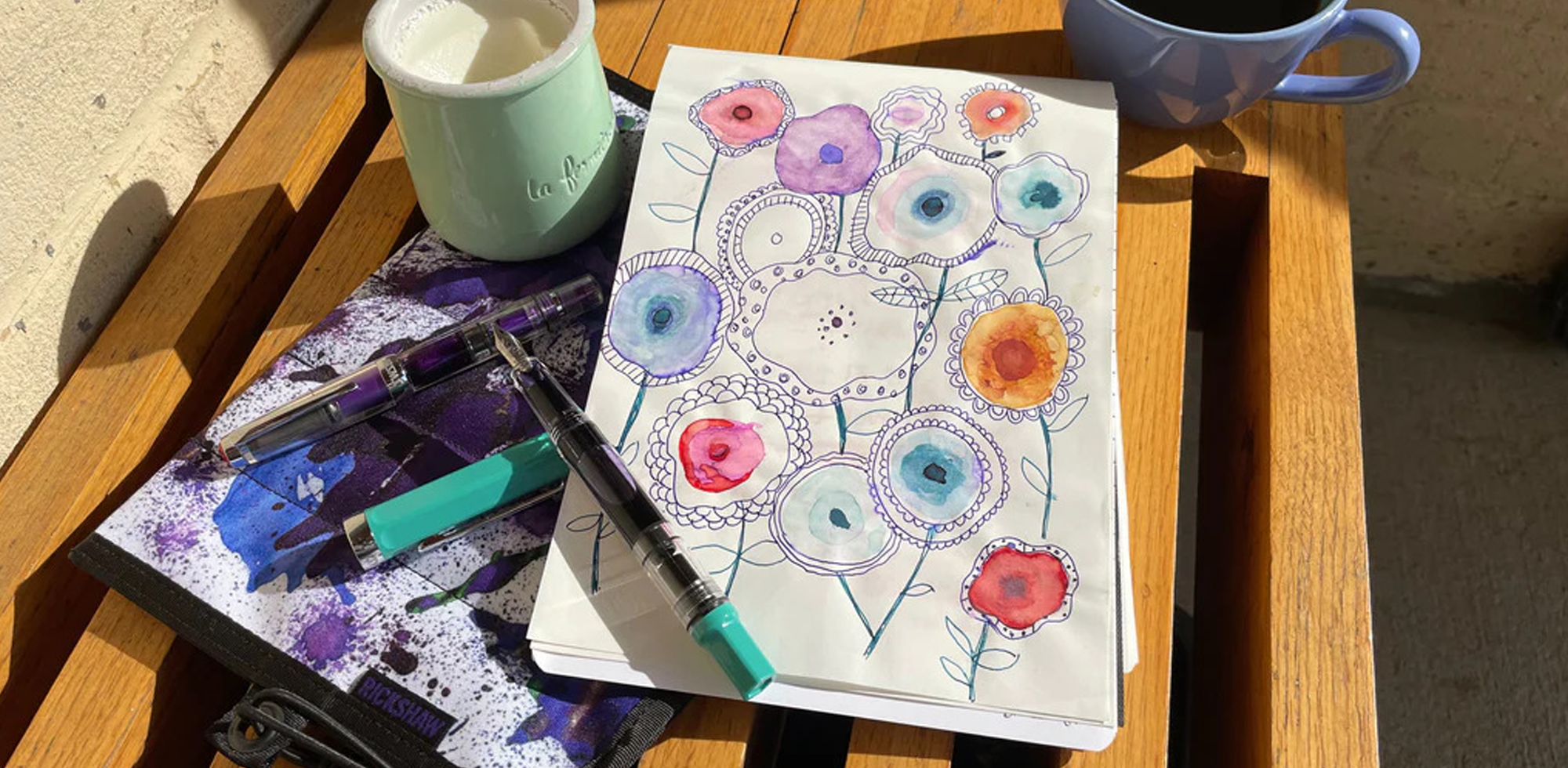
8 comments
Kim Buckley
I liked your informative, carefully, and well-written article on inlaid, inset, and hooded nibs. There is much there that I did not know or even think about before. Thanks very much.
I liked your informative, carefully, and well-written article on inlaid, inset, and hooded nibs. There is much there that I did not know or even think about before. Thanks very much.
Eric Arnold
How cool that you and Myk found a Sheaffer demonstrator to show how these nibs are mounted to the body! I was delighted to see this article, as I enjoy admiring and using these sorts of pens quite a bit! My Waterman Carene has been inked since I bought it, (a few years now) and sees daily use. Like all of my Waterman’s, it just writes.
I’ve had less luck with my Diplomat Viper, a dry slow starter, but I feel like I need to give it another chance and experiment with it a bit more with different inks. Like the Carene, my Parker 51 just writes, I enjoy that pen as well. I have also had a great experience with the Pilot E95.
I want to thank you for pointing me towards my latest acquisition, the Silvern Ishidatami! I did not know about this pen before this article, and it is marvelous compliment to my Ishime! The two are sitting adjacent to one another in the open holder, cooking up dreams of walks down cobbled paths in the moonlight! I’ve very much been enjoying it, and will write you another letter soon with it! By the way, for the initial ink, I went with Jacques Herbin Les Toits de Paris, a bit of a break for me as it is not a Pilot ink, but I think it turned out to compliment the pen quite well! As you know, I often match my inks to the color of the pen. In this case a silver ink was not really a reasonable choice, but Les Toits de Paris spills out of this pen like a liquid blue-grey moonlight and is perfect. I’ll bring it in next time I am in the store.
I do have to say that I was a wee bit disappointed to see that you did not include integral nibs in this article. They are a critical part of this area of fountain pen development, and can be quite interesting to use. I get it, I don’t know of any that are still in production and Pen Boutique does not focus at all on vintage pens (sadly!), but both the titanium and stainless pens of this sort produced by Parker and Pilot in the past are of interest, and are readily available in the vintage aftermarket. I feel like my Pilot Murex (stainless steel) is a nicer writer than my Parker IM Pioneer (titanium), but both are quite serviceable and stunning in their own way. Rumor has it that NASA went to Parker to obtain expertise in milling and working with titanium during the Apollo project, as Parker had the most knowledgeable folks in working with this difficult metal at the time! I wish we had the ability to post photos in these comments, as I’d love to share these pens!
Anyway, another fine article as always, I learned a lot as I do every time when reading your work, and your passion as a subject matter expert in the world of fountain pens always shines through! Thanks, for sharing that knowledge with us!
How cool that you and Myk found a Sheaffer demonstrator to show how these nibs are mounted to the body! I was delighted to see this article, as I enjoy admiring and using these sorts of pens quite a bit! My Waterman Carene has been inked since I bought it, (a few years now) and sees daily use. Like all of my Waterman’s, it just writes.
I’ve had less luck with my Diplomat Viper, a dry slow starter, but I feel like I need to give it another chance and experiment with it a bit more with different inks. Like the Carene, my Parker 51 just writes, I enjoy that pen as well. I have also had a great experience with the Pilot E95.
I want to thank you for pointing me towards my latest acquisition, the Silvern Ishidatami! I did not know about this pen before this article, and it is marvelous compliment to my Ishime! The two are sitting adjacent to one another in the open holder, cooking up dreams of walks down cobbled paths in the moonlight! I’ve very much been enjoying it, and will write you another letter soon with it! By the way, for the initial ink, I went with Jacques Herbin Les Toits de Paris, a bit of a break for me as it is not a Pilot ink, but I think it turned out to compliment the pen quite well! As you know, I often match my inks to the color of the pen. In this case a silver ink was not really a reasonable choice, but Les Toits de Paris spills out of this pen like a liquid blue-grey moonlight and is perfect. I’ll bring it in next time I am in the store.
I do have to say that I was a wee bit disappointed to see that you did not include integral nibs in this article. They are a critical part of this area of fountain pen development, and can be quite interesting to use. I get it, I don’t know of any that are still in production and Pen Boutique does not focus at all on vintage pens (sadly!), but both the titanium and stainless pens of this sort produced by Parker and Pilot in the past are of interest, and are readily available in the vintage aftermarket. I feel like my Pilot Murex (stainless steel) is a nicer writer than my Parker IM Pioneer (titanium), but both are quite serviceable and stunning in their own way. Rumor has it that NASA went to Parker to obtain expertise in milling and working with titanium during the Apollo project, as Parker had the most knowledgeable folks in working with this difficult metal at the time! I wish we had the ability to post photos in these comments, as I’d love to share these pens!
Anyway, another fine article as always, I learned a lot as I do every time when reading your work, and your passion as a subject matter expert in the world of fountain pens always shines through! Thanks, for sharing that knowledge with us!
Filpot
Thanks for a very informative article – and beautiful photos.
I may have missed it, but you didn’t mention the nib sizes available for each of the pens you describe, only for one of them.
I’ve recently been given a Lamy 2000 by my lovely husband, and I chose the OBB nib, because I wanted something big and bold, but also because I’ve never had an oblique nib before. It’s FABULOUS!
I’m now hankering after a Waterman Carene. I like the blue one, but am annoyed by the fact that the nib section of the barrel is black. It screams “cheap” at me, even though the pen is (on my budget) expensive. I have several lovely vintage Parker 51s, and love the fact that the barrel is the same colour all the way down the pen.
Thanks again for a great article.
Thanks for a very informative article – and beautiful photos.
I may have missed it, but you didn’t mention the nib sizes available for each of the pens you describe, only for one of them.
I’ve recently been given a Lamy 2000 by my lovely husband, and I chose the OBB nib, because I wanted something big and bold, but also because I’ve never had an oblique nib before. It’s FABULOUS!
I’m now hankering after a Waterman Carene. I like the blue one, but am annoyed by the fact that the nib section of the barrel is black. It screams “cheap” at me, even though the pen is (on my budget) expensive. I have several lovely vintage Parker 51s, and love the fact that the barrel is the same colour all the way down the pen.
Thanks again for a great article.
Shahriar Farkhan
I loved this post. Very informative!
I loved this post. Very informative!
judy jacobs
Laura, thanks as always for your good writing. I have a slight amendment to the facts, however. The white dot on Sheaffer pens was used to indicate the particular pen had a lifetime warranty. In the mid-century Sheaffer limited the promise to cover only the nib, and further to defects that were manufacturing issues, rather than user error. The meaning of the white dots went the way of lifetime guarantees, but still appear on Sheaffer products. https://www.penhero.com/PenGallery/Sheaffer/SheafferWhiteDot.htm
Laura, thanks as always for your good writing. I have a slight amendment to the facts, however. The white dot on Sheaffer pens was used to indicate the particular pen had a lifetime warranty. In the mid-century Sheaffer limited the promise to cover only the nib, and further to defects that were manufacturing issues, rather than user error. The meaning of the white dots went the way of lifetime guarantees, but still appear on Sheaffer products. https://www.penhero.com/PenGallery/Sheaffer/SheafferWhiteDot.htm
Stacy
I have what I think is a Sheaffer 330 in burgundy and a Parker 45 in blue that I love as general writers. (The 330 has an inlaid nib and the 45 has a half-hooded nib.) Both of them found me (at different times) without any stories of their past but with enough character to say they have lived.
I have what I think is a Sheaffer 330 in burgundy and a Parker 45 in blue that I love as general writers. (The 330 has an inlaid nib and the 45 has a half-hooded nib.) Both of them found me (at different times) without any stories of their past but with enough character to say they have lived.
AUGUSTINE ADERIYE
Thank you for the very informative article. While I was aware of the various nibs you discussed my preference is always Inlaid nibs because their beauty can be easily be admired. Not a fan of Hooded nibs even though I own several Parker 51s and Lamy 2000. I have the black and Burgundy Pilot E95s pens and they are my daily writers. You are very right about the smoothness of these pens. They write better than some of my pen with Ebonite feeds. I am looking to add a vintage E95s to my collection soon.
Thank you for the very informative article. While I was aware of the various nibs you discussed my preference is always Inlaid nibs because their beauty can be easily be admired. Not a fan of Hooded nibs even though I own several Parker 51s and Lamy 2000. I have the black and Burgundy Pilot E95s pens and they are my daily writers. You are very right about the smoothness of these pens. They write better than some of my pen with Ebonite feeds. I am looking to add a vintage E95s to my collection soon.
Quieter Elephant
Very informative – thanks for sharing.
I’m now inspired to write out my current pens and fill up my steel L2000 once more. Possibly the juiciest pen I own.
As for the Parker 51 (1941) being the first hooded nib – there’s some debate on that, with prior patents going back to the late C19 (though perhaps not making it into production) and a hooded French pen being on the market a few years earlier – the Stylomine 303D (1938). (https://www.fountainpen.it/File:1948-03-Stylomine-303D.jpg)
Very informative – thanks for sharing.
I’m now inspired to write out my current pens and fill up my steel L2000 once more. Possibly the juiciest pen I own.
As for the Parker 51 (1941) being the first hooded nib – there’s some debate on that, with prior patents going back to the late C19 (though perhaps not making it into production) and a hooded French pen being on the market a few years earlier – the Stylomine 303D (1938). (https://www.fountainpen.it/File:1948-03-Stylomine-303D.jpg)